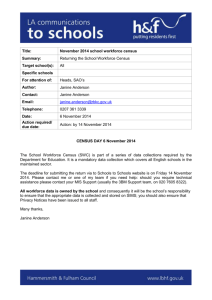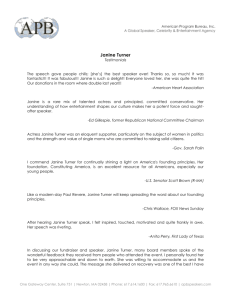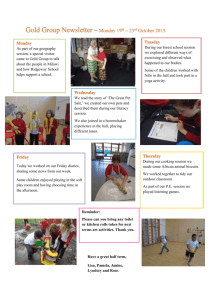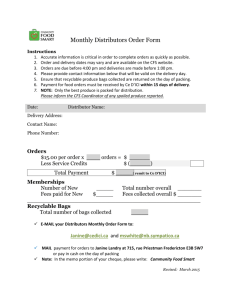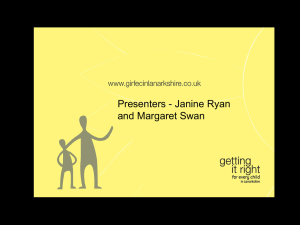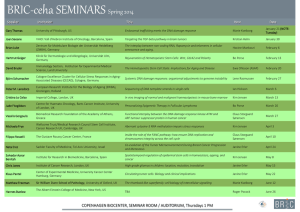Writers Workshop
advertisement
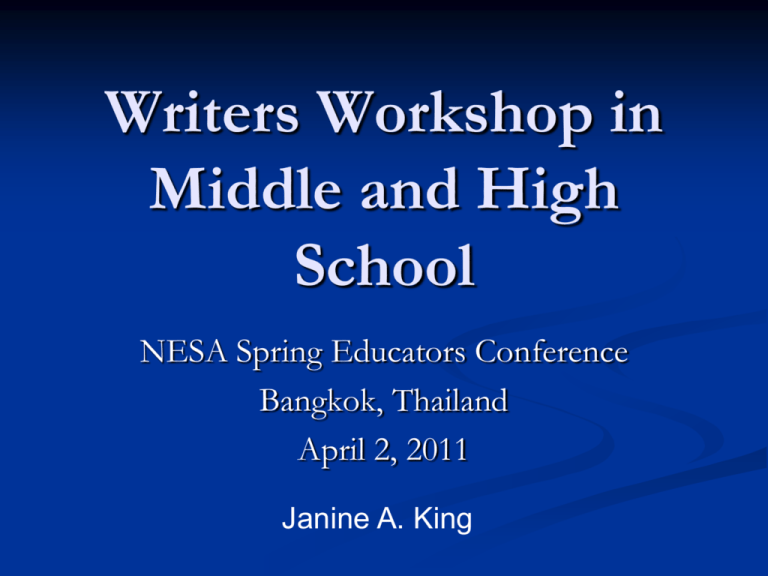
Writers Workshop in Middle and High School NESA Spring Educators Conference Bangkok, Thailand April 2, 2011 Janine A. King What is Workshop? Not a curriculum, but a set of structures and practices An environment that gives students the opportunity to bring their reading and writing lives into the classroom for the purpose of stretching themselves in the company of others A format that allows teachers to explicitly demonstrate the strategies and habits of mind employed by critical readers and writers Janine A. King Teaching the writer instead of ‘fixing’ the piece of writing Janine A. King The Importance of Environment Janine A. King Meeting Area Focus Tone Community of readers and writers Teacher as mentor (vs someone who is going to tell us what to do now) Janine A. King Collaborative Seating Arrangement Janine A. King Anchor Charts What - the skill or strategy being taught Why it is important How - an example Janine A. King Janine A. King The Mini-Lesson Short Direct One teaching point (posted) Explanation Modeling/demonstration/examples Janine A. King Notebooks: Writers Workshop Volume Growth Evidence of Generating and collecting ideas “Test Drives” Experimenting with craft Planning for drafting Janine A. King Partnerships Janine A. King Partners… Encourage each other Push each other Generate and develop ideas with each other Provide a constant audience Engage in active listening and learning Janine A. King Conferring Individualized instruction Differentiation Accountability Janine A. King Writers Workshop Janine A. King Why Writers Workshop? Choice Notebooks Explicit instruction Teacher demonstration Volume of writing Conferring Differentiation Independence Janine A. King The Writing Process Janine A. King The Features of a Personal Narrative Janine A. King Generating People/Places/Moments Janine A. King Writing Partners Encourage each other “Please read it to me.” “I like that part.” “I’d love to hear more about…” Push each other “I hear you saying…” “Why does this matter?” Generate ideas with each other “Wait! I need to add to my list.” “You just reminded me…” Practice Active Listening Face each other Make eye contact Sit up straight Janine A. King Generating People/Places/Moments People/Remarks/Emotions First Time/Last Time Musical Timeline Janine A. King Planning Janine A. King Janine A. King Drafting Out of the notebook On loose leaf paper Skip every other line Write about one event only Keep the issue/message in mind Why is this important? Janine A. King Revising Janine A. King What does it look like to add significant, specific detail? Include: Seasons, months, days of the week Weather Real names of streets, parks, stores Colors People’s appearances What are they wearing? How does it look on them? Hair, facial features and expressions Smiles, movements, brand names Janine A. King Editing Teach two or three lessons based on observations of students’ writing. Examples: Punctuating dialogue Paragraphs Commas Pronouns Verb tense Janine A. King Janine A. King Janine A. King Publish & Celebrate Read-around Whole grade or across grade levels Whole school Blogs ‘Coffee house’ Parent/community invitations Janine A. King Janine A. King Feedback Janine A. King Self-Reflection Where did the idea for this piece come from? How did the story/essay change from your original idea? What revision strategy had the biggest impact on this piece? What specific feedback was most meaningful/helpful? Why? Janine A. King Structure of a Workshop Janine A. King The Architecture of a Mini-lesson Teaching Point Connection Teach Active Engagement Link Share Janine A. King Personal Essay Janine A. King Generating “Issues” Janine A. King Generating Pulling ideas and issues from previous narrative entries in your notebooks Janine A. King Writing to Think Possible Thesis Statement because… For example… Another example is… This is important because… On the other hand… This makes me realize… Janine A. King Planning Developing and revising a thesis statement Boxes and bullets (Main idea and supporting details) Collecting evidence Janine A. King Evidence Personal anecdotes Books, movies A friend’s experience Interviews, quotes Facts from articles Statistics Janine A. King Drafting Synthesis of evidence for each bullet Use all you’ve learned about good writing Incorporate transitions Janine A. King Revising Make sure your subtopics are parallel but not repetitive Each paragraph focuses on one supporting idea Transitions are smooth and logical Lead is powerful (mentor texts) Conclusion leaves reader with a sense of closure (mentor texts) Janine A. King Editing Examples: Punctuating quotes Use of academic language Janine A. King Celebrating Students group essays by topic to invite readers Janine A. King Sample Units of Study Personal Narrative Raising the Level of Personal Narrative Personal Essay Fiction Literary Essay Memoir Poetry Janine A. King Fringe Benefits Increased student engagement Stronger student/teacher relationships Through sharing your own writing and conferring Teachers as writers Teacher collaboration More intentional planning Cohesive school community Janine A. King Resources The Writing Workshop: Working Through the Hard Parts (and They’re All Hard Parts) by Katie Wood Ray and Lester L. Laminack Assessing Writers by Carl Anderson Notebook Know-How: Strategies for the Writer’s Notebook by Aimee Buckner Units of Study for Teaching Writing, Grades 3-5 by Lucy Calkins Thinking Through Genre: Units of Study in Reading and Writing Workshops Grades 4-12 by Heather Lattimer Janine A. King Resources (continued) Personal Narrative Marshfield Dreams by Ralph Fletcher The Glass Castle by Jeanette Wells Knots in My Yo-yo String by Jerry Spinelli Personal Essay Starting With “I”: Personal Essays by Teenagers by Youth Communication, Andrea Estepa, and Phillip Kay This I Believe: The Personal Philosophies of Remarkable Men and Women by James Allison, Dan Gediman, and Studs Terkel Janine A. King
